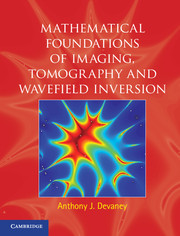Book contents
- Frontmatter
- Contents
- Preface
- 1 Radiation and initial-value problems for the wave equation
- 2 Radiation and boundary-value problems in the frequency domain
- 3 Eigenfunction expansions of solutions to the Helmholtz equation
- 4 Angular-spectrum and multipole expansions
- 5 The inverse source problem
- 6 Scattering theory
- 7 Surface scattering and diffraction
- 8 Classical inverse scattering and diffraction tomography
- 9 Waves in inhomogeneous media
- 10 Time-reversal imaging for systems of discrete scatterers
- 11 The electromagnetic field
- Appendix A Proof of the scattering amplitude theorems
- Appendix B Derivation of the generalized Weyl expansion
- References
- Index
2 - Radiation and boundary-value problems in the frequency domain
Published online by Cambridge University Press: 05 July 2012
- Frontmatter
- Contents
- Preface
- 1 Radiation and initial-value problems for the wave equation
- 2 Radiation and boundary-value problems in the frequency domain
- 3 Eigenfunction expansions of solutions to the Helmholtz equation
- 4 Angular-spectrum and multipole expansions
- 5 The inverse source problem
- 6 Scattering theory
- 7 Surface scattering and diffraction
- 8 Classical inverse scattering and diffraction tomography
- 9 Waves in inhomogeneous media
- 10 Time-reversal imaging for systems of discrete scatterers
- 11 The electromagnetic field
- Appendix A Proof of the scattering amplitude theorems
- Appendix B Derivation of the generalized Weyl expansion
- References
- Index
Summary
We return to the problem of computing the field u+(r, t) radiated by a real-valued spaceand time-varying source q(r, t) embedded in an infinite homogeneous medium such as free space. As in Chapter 1 we will assume here that the time-dependent source q(r, t) is compactly supported in the space-time region {S0|r ϵ τ0, ϵ t ϵ [0, T0]}, where τ0 is its spatial volume and [0, T0] the interval of time over which the source is turned on. In the case in which the medium is non-dispersive the radiated wavefield satisfies the inhomogeneous scalar wave equation Eq. (1.1). More generally, if the background medium is dispersive it is necessary to replace the second time derivative in this equation by an integral (convolutional) operator, so that the wave equation is actually an integral-differential equation. In this chapter we will treat the radiation problem in the frequency domain so that this complication is avoided and our results apply both to dispersive and to non-dispersive backgrounds.
In addition to treating the radiation problem we also treat the classical boundary value problem for the scalar wave Helmholtz equation in a (possibly dispersive) uniform background medium. Special attention is devoted to the famous Rayleigh–Sommerfeld boundary-value problem, which consists of computing a radiated field throughout a half-space that is exterior to the source region τ0 from Dirichlet or Neumann conditions prescribed over an infinite bounding plane to the source.
- Type
- Chapter
- Information
- Publisher: Cambridge University PressPrint publication year: 2012
- 1
- Cited by



